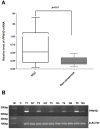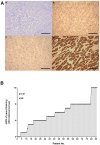Protein phosphatase magnesium-dependent 1δ (PPM1D) mRNA expression is a prognosis marker for hepatocellular carcinoma
- PMID: 23556002
- PMCID: PMC3610683
- DOI: 10.1371/journal.pone.0060775
Protein phosphatase magnesium-dependent 1δ (PPM1D) mRNA expression is a prognosis marker for hepatocellular carcinoma
Abstract
Background: Protein phosphatase magnesium-dependent 1δ (PPM1D) is an oncogene, overexpressed in many solid tumors, including ovarian cancer and breast cancer. The current study examined the expression and the prognostic value of PPM1D mRNA in human hepatocellular carcinoma (HCC).
Methods: Total RNA was extracted from 86 HCC and paired non-cancerous liver tissues. PPM1D mRNA expression was determined by real-time quantitative reverse transcriptase-polymerase chain reaction (qPCR). Immunohistochemistry assay was used to verify the expression of ppm1d protein in the HCC and non-cancerous liver tissues. HCC patients were grouped according to PPM1D mRNA expression with the average PPM1D mRNA level in non-cancerous liver tissue samples as the cut-off. Correlations between clinicopathologic variables, overall survival and PPM1D mRNA expression were analyzed.
Findings: PPM1D mRNA was significantly higher in HCC than in the paired non-cancerous tissue (p<0.01). This was confirmed by ppm1d staining. 56 patients were classified as high expression group and the other 30 patients were categorized as low expression group. There were significant differences between the two groups in term of alpha-fetoprotein (α-FP) level (p<0.01), tumor size (p<0.01), TNM stage (p<0.01), recurrence incidence (p<0.01) and family history of liver cancer (p<0.01). The current study failed to find significant differences between the two groups in the following clinical characteristics: age, gender, portal vein invasion, lymphnode metastasis, hepatitis B virus (HBV) infection and alcohol intake. Survival time of high expression group was significantly shorter than that of low expression group (median survival, 13 months and 32 months, respectively, p<0.01).
Conclusion: Up-regulation of PPM1D mRNA was associated with progressive pathological feature and poor prognosis in HCC patients. PPM1D mRNA may serve as a prognostic marker in HCC.
Conflict of interest statement
Figures



Similar articles
-
Upregulation of Leucine Zipper Protein mRNA in Hepatocellular Carcinoma Associated With Poor Prognosis.Technol Cancer Res Treat. 2016 Jun;15(3):517-22. doi: 10.1177/1533034615587432. Epub 2015 Jun 1. Technol Cancer Res Treat. 2016. PMID: 26031464
-
PPM1D is a potential prognostic biomarker and correlates with immune cell infiltration in hepatocellular carcinoma.Aging (Albany NY). 2021 Sep 1;13(17):21294-21308. doi: 10.18632/aging.203459. Epub 2021 Sep 1. Aging (Albany NY). 2021. PMID: 34470916 Free PMC article.
-
Protein phosphatase magnesium-dependent 1δ is a novel tumor marker and target in hepatocellular carcinoma.Front Med. 2016 Mar;10(1):52-60. doi: 10.1007/s11684-016-0433-3. Epub 2016 Jan 25. Front Med. 2016. PMID: 26809466
-
Down-regulation of the tumour suppressor κ-opioid receptor predicts poor prognosis in hepatocellular carcinoma patients.BMC Cancer. 2017 Aug 18;17(1):553. doi: 10.1186/s12885-017-3541-9. BMC Cancer. 2017. PMID: 28821282 Free PMC article.
-
Hepatocellular carcinoma: a clinical and pathological overview.Pathologica. 2021 Jun;113(3):203-217. doi: 10.32074/1591-951X-295. Pathologica. 2021. PMID: 34294938 Free PMC article. Review.
Cited by
-
Co-targeting WIP1 and PARP induces synthetic lethality in hepatocellular carcinoma.Cell Commun Signal. 2022 Mar 28;20(1):39. doi: 10.1186/s12964-022-00850-2. Cell Commun Signal. 2022. PMID: 35346236 Free PMC article.
-
Wip1 contributes to the adaptation of HepG2 human liver cancer cells to stress hormone-induced DNA damage.Oncol Lett. 2022 Nov 29;25(1):31. doi: 10.3892/ol.2022.13617. eCollection 2023 Jan. Oncol Lett. 2022. PMID: 36589663 Free PMC article.
-
Novel hepatocellular carcinoma molecules with prognostic and therapeutic potentials.World J Gastroenterol. 2014 Feb 7;20(5):1268-88. doi: 10.3748/wjg.v20.i5.1268. World J Gastroenterol. 2014. PMID: 24574801 Free PMC article. Review.
-
High expression of peroxisomal D-bifunctional protein in cytosol regulates apoptosis and energy metabolism of hepatocellular carcinoma cells via PI3K/AKT pathway.Am J Cancer Res. 2023 May 15;13(5):1884-1903. eCollection 2023. Am J Cancer Res. 2023. PMID: 37293151 Free PMC article.
-
Cisplatin induces HepG2 cell cycle arrest through targeting specific long noncoding RNAs and the p53 signaling pathway.Oncol Lett. 2016 Dec;12(6):4605-4612. doi: 10.3892/ol.2016.5288. Epub 2016 Oct 18. Oncol Lett. 2016. PMID: 28105167 Free PMC article.
References
-
- Hussain SP, Schwank J, Staib F, Wang XW, Harris CC (2007) TP53 mutations and hepatocellular carcinoma: insights into the etiology and pathogenesis of liver cancer. Oncogene 26: 2166–2176. - PubMed
-
- Staib F, Hussain SP, Hofseth LJ, Wang XW, Harris CC (2003) TP53 and liver carcinogenesis. Hum Mutat 21: 201–216. - PubMed
-
- Mazzanti R, Gramantieri L, Bolondi L (2008) Hepatocellular carcinoma: epidemiology and clinical aspects. Mol Aspects Med 29: 130–143. - PubMed
MeSH terms
Substances
LinkOut - more resources
Full Text Sources
Other Literature Sources
Medical

